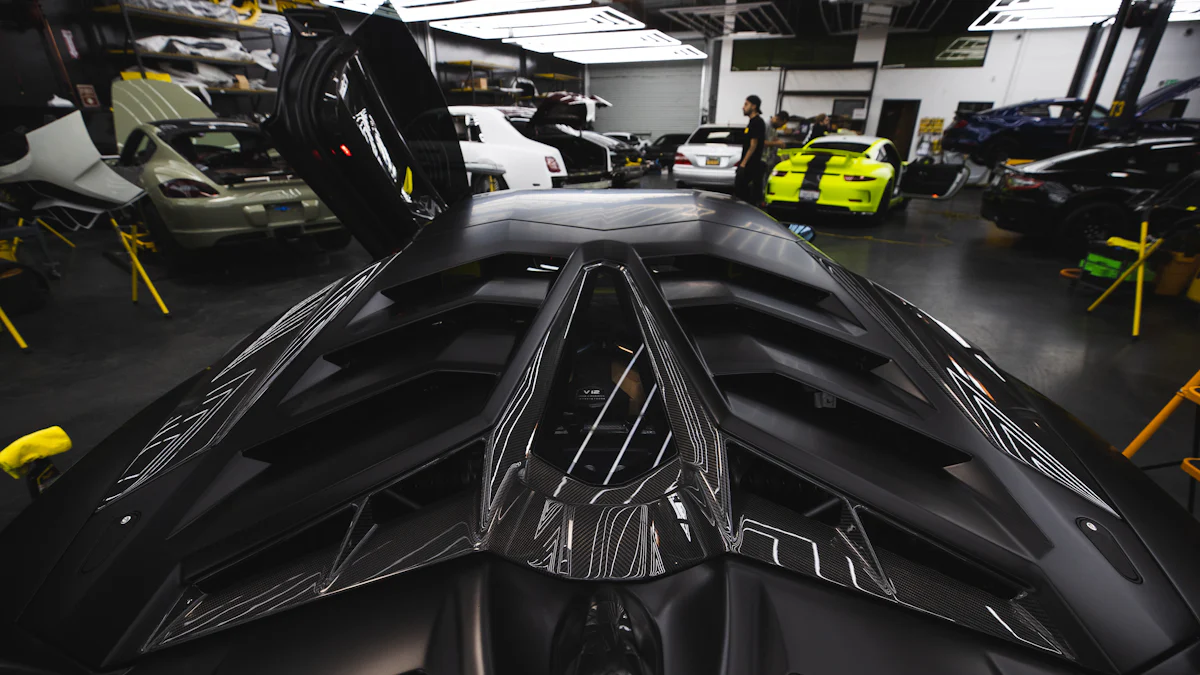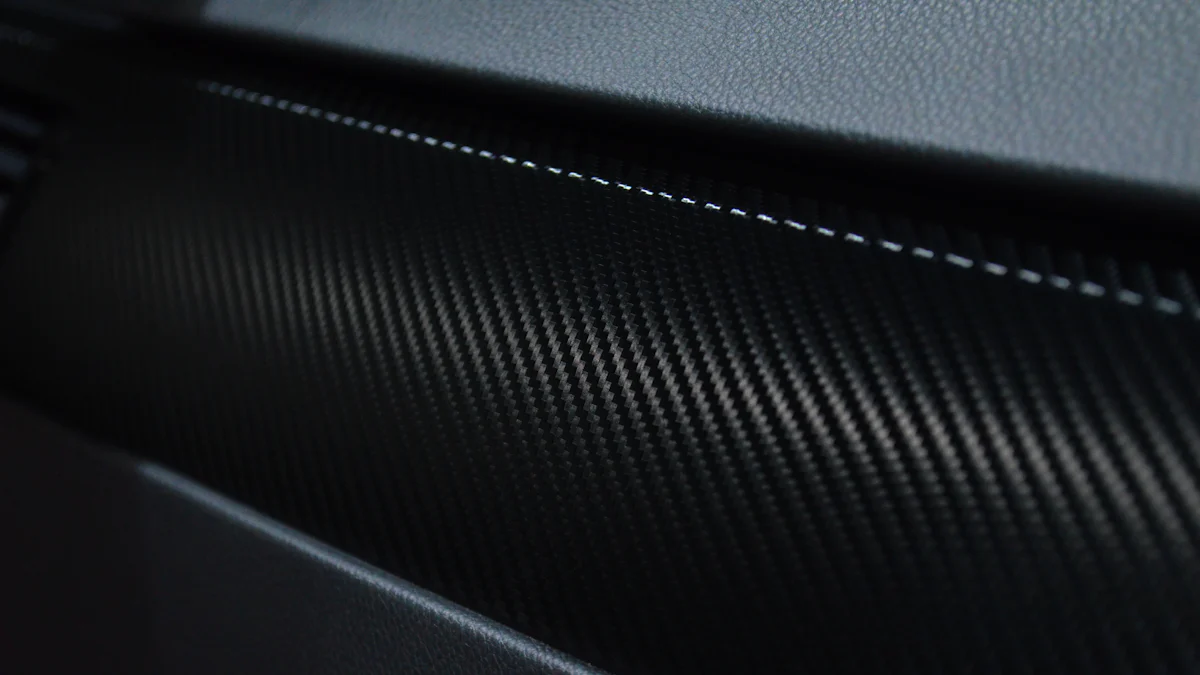2025 Ferrari Carbon Fiber Advancements to Watch

Ferrari carbon fiber has revolutionized the way supercars are designed. Its lightweight strength, corrosion resistance, and high tensile properties make it a game-changer in the automotive world. You can see its impact in iconic models like the Ferrari Enzo, which set new standards for performance. By 2025, Ferrari plans to push boundaries further with innovations like hybrid powertrains and sustainable materials. These advancements aim to balance speed, agility, and eco-consciousness, ensuring Ferrari remains a leader in supercar innovation.
Carbon fiber is no longer limited to niche applications. Its adoption is growing rapidly, driven by the need for efficiency and sustainability in modern vehicles.
Key Takeaways
Ferrari uses carbon fiber to make cars lighter and faster.
New ideas like self-fixing materials and smart sensors make parts stronger and track performance.
Ferrari cares about the planet by reusing carbon fiber and saving energy during production.
The 2025 models, like the Ferrari F80 and 499 GTB, use light carbon fiber and hybrid engines for better efficiency.
Ferrari’s focus on new ideas keeps its cars fast, fancy, and eco-friendly.
Why Carbon Fiber Matters in Supercars
Unique Properties of Carbon Fiber
Lightweight strength for enhanced performance
Carbon fiber stands out due to its exceptional strength-to-weight ratio. It provides the structural integrity of steel while being significantly lighter. This property allows supercars to achieve better acceleration, improved handling, and higher top speeds. For example, Ferrari uses carbon fiber to reduce vehicle weight, which directly enhances performance.
Property | Description |
|---|---|
Weight Reduction | Carbon fiber reduces vehicle weight, improving fuel efficiency and performance. |
Strength-to-Weight Ratio | Offers high strength while being lighter than metals, enhancing safety and structural integrity. |
Corrosion Resistance | Resists rust and corrosion, increasing durability and reducing maintenance needs. |
Enhanced Performance | Contributes to better handling, acceleration, and top speed due to reduced weight. |
Aesthetic Appeal | Valued for its modern appearance, appealing in high-end vehicles. |
Heat resistance and durability in extreme conditions
You’ll find carbon fiber in supercars because it withstands extreme heat and stress. This makes it ideal for components like brake systems and engine bays. Its durability ensures that high-performance vehicles maintain reliability even under intense conditions, such as track racing or high-speed driving.
Ferrari’s Legacy with Carbon Fiber
Early adoption in Formula 1 engineering
Ferrari pioneered the use of carbon fiber in Formula 1 during the 1980s. The material improved performance by reducing weight and increasing structural rigidity. Over time, Ferrari integrated carbon fiber into various components, including chassis and aerodynamic elements. This innovation set the stage for its use in road cars.
The Ferrari 812 Competizione incorporates carbon fiber for mass reduction and air management.
Extensive use of carbon fiber is found in body shells, bumpers, spoilers, and air intakes.
These advancements highlight Ferrari’s commitment to performance and innovation.
Transitioning innovations to road cars
Ferrari transitioned its Formula 1 expertise to road cars, creating models like the Ferrari 812 Competizione. This vehicle uses carbon fiber extensively, making it 38 kilograms lighter than its predecessor, the 812 Superfast. The material enhances both performance and aerodynamics, showcasing Ferrari’s ability to adapt racing technology for everyday use.
Carbon Fiber’s Role in Supercar Design Trends
Supporting aerodynamic and futuristic designs
Carbon fiber enables the creation of complex aerodynamic shapes, which are essential for modern supercars. Lightweight materials like carbon fiber reduce drag and improve handling. For instance, the Ferrari Enzo utilized a carbon fiber monocoque chassis to enhance both performance and aesthetics.
Enabling speed and agility in modern supercars
Supercars rely on carbon fiber to achieve unmatched speed and agility. By reducing weight, the material allows for quicker acceleration and sharper cornering. This makes it a cornerstone of supercar design trends, ensuring vehicles remain competitive in the high-performance market.
Key Advancements in Ferrari Carbon Fiber Technology for 2025

Next-Generation Materials
Ultra-lightweight composites for reduced weight
Ferrari is introducing ultra-lightweight composite materials in 2025 to redefine supercar performance. These materials reduce the overall weight of the vehicle, allowing for secondary weight savings in other components. For example, a lighter body enables the use of a smaller engine, which further decreases weight. This cascading effect enhances fuel efficiency and agility, making the car faster and more responsive. You’ll notice how these advancements align with Ferrari’s commitment to cutting-edge technology and innovation in composite materials.
Improved strength-to-weight ratios for better performance
The new composites also offer improved strength-to-weight ratios. This means you get a material that is both lighter and stronger than traditional options. Ferrari’s engineers are leveraging this to enhance structural integrity without compromising on weight. The result is a supercar that delivers exceptional performance, whether on the track or the road.
Advanced Manufacturing Techniques
3D printing for precision and efficiency
Ferrari is embracing 3D printing to revolutionize the manufacturing of carbon fiber components. This technology allows for the creation of intricate designs that traditional methods cannot achieve. It also retains the strength and stiffness of virgin carbon fiber, ensuring durability. Additionally, 3D printing reduces waste and costs, making it an environmentally friendly choice. You’ll see its impact in the precision and efficiency of Ferrari’s 2025 models.
Additive manufacturing for faster production
Additive manufacturing is another game-changer for Ferrari. This method simplifies production by combining multiple parts into a single step. It also minimizes waste, which reduces costs and environmental impact. By using additive manufacturing, Ferrari can produce lighter components that improve performance and speed. This approach ensures that Ferrari stays ahead in the competitive supercar market.
Smart Carbon Fiber Integration
Self-healing materials for durability
Ferrari is exploring self-healing carbon fiber materials to enhance durability. These materials can repair minor damages, such as cracks or scratches, on their own. This innovation reduces maintenance needs and extends the lifespan of the vehicle. For you, this means owning a Ferrari that stays in peak condition for longer.
Embedded sensors for real-time performance monitoring
Embedded sensors in carbon fiber components are another exciting advancement for 2025. These sensors track real-time data, such as speed, acceleration, and vehicle position. They also monitor structural health, ensuring optimal performance at all times. This smart integration represents the future of Ferrari carbon fiber technology, combining performance with advanced monitoring capabilities.
Ferrari’s advancements in carbon fiber technology for 2025 showcase its dedication to innovation and sustainability. These cutting-edge developments promise to elevate the supercar experience to new heights.
Impact on Performance and Design

Enhanced Performance Capabilities
Improved acceleration and top speed
Ferrari’s advancements in carbon fiber for 2025 are redefining what you can expect from state-of-the-art performance. By using ultra-lightweight composites, Ferrari reduces vehicle weight, which directly improves acceleration and top speed. Lighter cars require less energy to move, allowing engines to deliver more power to the wheels. This results in quicker sprints and higher velocity on straightaways. For example, Ferrari’s automated manufacturing processes increase production speed by 25% and improve material consistency by 30%, ensuring every component contributes to peak performance.
Better handling and cornering stability
Ferrari’s integration of smart carbon fiber materials enhances handling and cornering stability. Technologies like Side Slip Control dynamically distribute torque, giving you optimal traction during sharp turns. Carbon fiber’s rigidity also ensures the chassis remains stable under high stress, improving control. These innovations make Ferrari’s supercars more agile and responsive, whether on the track or winding roads.
Technology | Contribution to Handling and Cornering Stability |
|---|---|
Ferrari’s Side Slip Control (SSC) | Dynamically distributes torque for better traction. |
Active Suspension Systems | Adjusts damping for superior comfort and handling. |
Revolutionary Supercar Design Trends
Aerodynamic shapes for speed optimization
Carbon fiber enables Ferrari to create bold designs with active aerodynamic components. These features balance drag reduction and downforce, ensuring stability at high speeds. Tools like Computational Fluid Dynamics (CFD) and wind tunnel testing help Ferrari refine these shapes. For instance, streamlined bodywork and diffusers manage airflow efficiently, boosting both speed and control. This approach keeps Ferrari at the forefront of supercar design trends.
Customization options for exclusive client needs
Ferrari’s use of carbon fiber also caters to your desire for exclusivity. The material’s versatility allows for bespoke designs, from unique body shapes to custom finishes. Limited-production models like the Ferrari Enzo showcase how carbon fiber combines performance and luxury. This level of personalization ensures your Ferrari stands out as a masterpiece of engineering and design.
Weight Reduction and Efficiency
Lower fuel consumption in hybrid models
Weight reduction plays a crucial role in Ferrari’s hybrid models. Lighter vehicles consume less fuel, making them more efficient without sacrificing performance. Ferrari’s focus on electrification aligns with this trend, as lighter hybrids achieve better mileage and reduced emissions.
Increased range for electric supercars
For electric supercars, weight reduction directly increases range. A lighter car requires less energy for propulsion, allowing you to travel farther on a single charge. Ferrari’s advancements in carbon fiber ensure their electric models deliver exceptional range while maintaining the performance you expect. This innovation positions Ferrari as a leader in sustainable, high-performance vehicles.
Ferrari’s 2025 carbon fiber advancements are shaping the future of performance and luxury. From improved speed and handling to revolutionary designs, these innovations ensure Ferrari remains a pioneer in supercar excellence.
Sustainability and Future Implications
Eco-Friendly Manufacturing Processes
Recycling and reusing carbon fiber materials
Ferrari is leading the way in recycling and reusing carbon fiber materials. By repurposing leftover composites, Ferrari reduces waste and minimizes its environmental footprint. This approach not only conserves resources but also ensures that high-performance materials remain part of the production cycle. For you, this means driving a supercar that embodies both innovation and responsibility.
Reduced energy consumption in production
Ferrari’s manufacturing processes are designed to conserve energy and resources. These methods reduce energy consumption by 80%, water usage by 88%, and chemical usage by 90%. Waste is also cut by up to 70%. These advancements demonstrate Ferrari’s commitment to sustainability without compromising on performance and luxury.
Long-Term Benefits for the Automotive Industry
Setting new sustainability standards
Ferrari is setting benchmarks for sustainability in the automotive world. By prioritizing carbon neutrality and diversifying its product portfolio, Ferrari aligns with global environmental goals. The company’s strategy addresses both direct and indirect greenhouse gas emissions, ensuring a comprehensive approach to sustainability.
Inspiring industry-wide adoption of green practices
Ferrari’s efforts inspire other automakers to adopt greener practices. The company’s focus on energy efficiency, sustainable materials, and electrification drives innovation across the industry.
Aspect | Benefit |
|---|---|
Research and Development | Drives technological innovation in the industry |
Collaboration with Partners | Enhances sustainability practices across the sector |
Ferrari’s leadership encourages the entire automotive sector to embrace eco-friendly trends, paving the way for a greener future.
Ferrari’s Green Vision for 2025
Aligning with global environmental goals
Ferrari’s vision for 2025 includes ambitious sustainability goals. The company aims to achieve carbon neutrality by 2030 and reduce Scope 3 emissions per car by at least 40%. Projects at Maranello, such as using biomethane for energy and installing hydrogen fuel cells, reflect Ferrari’s dedication to aligning with global environmental objectives.
Balancing high performance with sustainability
Ferrari’s 2025 vision balances high performance with sustainability. The company actively researches new technologies and materials to enhance sustainability while maintaining its legacy of excellence. As Ferrari states, “our interpretation and application of these technologies both in motorsport and in road cars is a huge opportunity to bring the uniqueness and passion of Ferrari to new generations.” This approach ensures that Ferrari carbon fiber innovations continue to lead the way in performance and luxury.
Ferrari’s commitment to sustainability ensures that you can enjoy cutting-edge technology and eco-conscious design in every model.
What to Expect from Ferrari in 2025
Upcoming Models Featuring Ferrari Carbon Fiber
The 2025 Ferrari F80 and its lightweight chassis
The 2025 Ferrari F80 showcases a groundbreaking lightweight chassis that redefines supercar engineering. Its carbon fiber composites provide exceptional strength while keeping the weight to a minimum. Aluminum subframes at the front and rear, secured with titanium fasteners, enhance the structural integrity. Hollow carbon-fiber sills act as load-bearing elements, increasing rigidity and supporting a driver-centric cabin design. This innovative approach not only improves aerodynamics but also ensures the F80 delivers unmatched performance on the road and track.
The 2025 Ferrari 499 GTB and hybrid power integration
The 2025 Ferrari 499 GTB represents the perfect blend of electrification and cutting-edge carbon fiber technology. Its hybrid powertrain integrates seamlessly with a lightweight carbon fiber body, optimizing energy efficiency and speed. The reduced weight enhances the car’s agility, while the hybrid system provides instant torque for rapid acceleration. This model highlights Ferrari’s commitment to combining sustainability with high-performance engineering.
Ferrari’s Vision for Supercar Design Trends
Expanding carbon fiber applications beyond vehicles
Ferrari continues to push the boundaries of carbon fiber applications. Beyond vehicles, the company explores its use in manufacturing tools, production equipment, and even architectural elements. These advancements demonstrate Ferrari’s dedication to innovation and its influence on broader design trends.
Continued innovation in materials science
Ferrari’s focus on materials science drives its ability to stay ahead in the supercar market. The company uses 3D printing to create lightweight, precise components that improve handling and safety. For example, 3D-printed upper wishbones in the suspension system enhance performance by optimizing suspension dynamics. This technology also allows for complex geometries, enabling Ferrari to achieve designs that were previously impossible.
Competitive Edge in Performance and Design
Staying ahead in the supercar market
Ferrari’s strong brand image, built on Formula One success and high-performance cars, ensures its dominance in the supercar market. By limiting production to around 10,000 cars annually, Ferrari maintains exclusivity and desirability. The company also invests heavily in research and development to pioneer new technologies and materials.
Maintaining Ferrari’s reputation for excellence
Ferrari’s strategy focuses on preserving the emotional connection between driver and machine. By limiting car autonomy to L2/L2+ levels, Ferrari ensures you experience the thrill of driving. This approach, combined with its commitment to sustainability and electrification, solidifies Ferrari’s reputation as a leader in performance and innovation.
Ferrari’s 2025 models and design trends highlight its dedication to pushing boundaries while staying true to its legacy. You can expect nothing less than excellence from this iconic brand.
Ferrari’s advancements in carbon fiber technology for 2025 redefine what you can expect from supercars. These innovations improve performance, enhance groundbreaking designs, and set new standards for sustainability. You see how Ferrari balances cutting-edge materials with eco-friendly practices, ensuring a future where luxury meets responsibility. As a leader in the automotive world, Ferrari continues to inspire with its bold vision and commitment to excellence. The road ahead promises even more exciting developments, keeping Ferrari at the forefront of supercar innovation.
FAQ
What makes carbon fiber essential for Ferrari supercars?
Carbon fiber offers unmatched strength and lightweight properties. It enhances speed, agility, and durability. Ferrari uses it to improve performance and create aerodynamic designs. Its heat resistance also ensures reliability in extreme conditions, making it a cornerstone of Ferrari’s engineering.
How does Ferrari use carbon fiber in its 2025 models?
Ferrari integrates carbon fiber into chassis, body panels, and aerodynamic components. The 2025 models feature ultra-lightweight composites, self-healing materials, and embedded sensors. These innovations improve performance, reduce weight, and enhance durability, ensuring a superior driving experience.
Are Ferrari’s carbon fiber advancements sustainable?
Yes, Ferrari focuses on eco-friendly manufacturing processes. Recycling and reusing carbon fiber materials reduce waste. Energy-efficient production methods minimize environmental impact. These efforts align with Ferrari’s commitment to sustainability and global environmental goals.
What benefits do self-healing carbon fiber materials offer?
Self-healing materials repair minor damages like cracks or scratches automatically. This reduces maintenance costs and extends the lifespan of components. For you, this means owning a Ferrari that stays in excellent condition longer, ensuring reliability and value.
How does carbon fiber improve electric supercars?
Carbon fiber reduces weight, increasing the range of electric supercars. Lighter vehicles require less energy, allowing you to travel farther on a single charge. Ferrari’s carbon fiber advancements ensure electric models deliver exceptional performance and efficiency.
